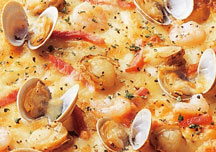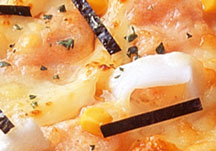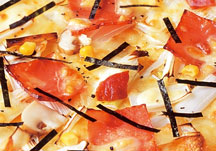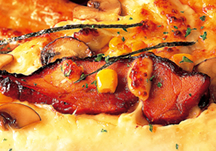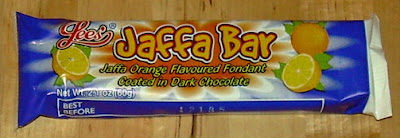There's
a scene in the second Indiana Jones movie in which he and the blond woman who kept screaming all of the time and the little boy they were running around with for some reason in which they are all served monkey brains. The brains are evocatively served in the heads they were once functioning within. The point of the entire dinner scene is to watch the hapless heroine, who was so annoying that I saw the movie once or twice and never watched it again, and the little boy, who was annoying but not nearly as much as the ditzy woman who later married Stephen Spielberg, freak out over the weird food. Their hosts nosh happily on these delicacies, but they are abhorrent to their guests.
One thing about food is that one man's feasting fungi is another man's toe fungi. The Japanese would eat live prawns, partially filleted but still living fish,
poisonous blowfish, and
offal. Some of these are delicacies and some are just plain people food (that'd be the offal). What one culture considers good eats, another finds disgusting. I've learned, for instance, that there are parts of the world that think mixing chocolate and peanut butter is a vile idea and that there are even more that find root beer truly disgusting (the Japanese certainly hate it, I know because I gave it to some to see how they'd react).
Even the most disgusting things can, over time, become quite palatable and even enjoyable with time, experience, and just generally allowing yourself to get used to the fact that it's something people find pretty tasty. In my early years in Japan, the idea of buying a brick of sweetened bean jelly for a snack would have seemed pretty gross. It's not monkey-brains-level gross, but I didn't even like beans in their more common savory presentations in America. I surely didn't think I'd like them mixed with sugar. Perish the thought!
Well, many Americans still recoil at the idea of sweet red bean paste (anko), but we're starting to see an awful lot of recipes for things like black bean brownies and cake as well as blondies made with white beans or chickpeas. There are entire blogs by fresh-faced, skinny, young white girls that are filled with sweets subbing in beans for flour to add moisture and density without the evils of flour. We're not through the sweet bean looking glass yet, but we're well on our way, kids.
Getting to the matter at hand, I had a moment that I thought I would never have at a grubby little Korean market located near Little Russia in San Francisco. Note, there is very little "Russia" in little Russia in that city and it was pretty disappointing. At any rate, I nearly "squeed" my pants when I saw this bar on sale and was even happier that it was only 50 cents for a 1.9 oz/55 gram bar. The reason it is so cheap is that it is a "product of Korea" that is marketed in both Japan and its native country. If I've learned anything from frequenting Asian markets in California, it's that anything made in Japan costs at least double what is made for Japan in other Asian countries. This is why more and more snack products aren't actually being made in Japan.
The company that makes this is Korean, but it used to be owned in part by big name brew maker Asahi. Two years ago, Asahi sold it's 20% stake in the company because it decided it would rather hitch its wagon to Lotte (who wouldn't? Lotte makes
Ghana, after all!). Howver,
Haitai makes a product called "choco homerun ball", so I find it hard to believe Asahi walked away from a product so named. Just think of all of the risky jokes they could have made! Though I linked to the English site, the Korean site is much better if you don't count the fact that I can't read any of it. Note that this bar isn't prominently mentioned on the site, but I guess that they have to focus on their more major products like the "Oh, Yes!" cakes and the aforementioned balls.
This bar is what the Japanese call "yokan" or jellied bean paste. It's very soft and I have to squeeze it up through its foil tube like super thick toothpaste to eat it. It is actually less "jelly" than "paste" and has a nice soft texture which feels like super smooth fudge without any of the pesky things like fat or chocolate. It is quite sweet, but not cloying, and does have that familiar undercurrent of red bean flavoring.
I'm not going to try and persuade anyone who sees this as monkey brains that they're going to love it. The truth is that you have to sometimes make a special effort to love some things that are outside of your general native cultural palate and many people aren't really interested in bothering (for which I can't blame them, really). I learned to love this after many years and really enjoyed this bar. I'd absolutely buy it again, especially considering how cheap it is. If you like anko, this is a treat. If not, this is not going to win you over.























